Music, it’s the universal language that unites us all. It’s been a part of human existence since time immemorial, evolving with us through ages and civilizations. This article embarks on a fascinating journey, tracing the rich and diverse history of music timeline.
History of Music Timeline
Embarking on the history of music timeline, the expedition reaches the early stages where the symphonies of the past were weaved. Delve deeper into the musical timeline to explore the Medieval and Renaissance periods, where unique musical innovations brought vibrant hues to the art of sound.

The Medieval period, which spanned from 500 to 1400 AD, demonstrated an evolution in the sonic landscape. During this epoch, music crafted its own identity, stepping away from the primal beats of preceding eras. Monophonic chants, characterized by a single melodic line without accompaniment, dominated the era, reflecting the prevalent religious ethos. Gregorian Chant, named after Pope Gregory I, is an exemplar of this monophonic music form, often found echoing in the sacred halls of churches.
In contrast with the monophonic structure of Medieval music, the Renaissance period, spanned from 1400 to 1600, brought forth polyphony—a novel music form. Polyphony features multiple melodic lines playing concurrently, producing a rich, harmonious blend of sounds.
From Digital to Global: The Contemporary Music History
The Rise of Electronic and Digital Mediums
The mid-20th century delivered a monumental shift in history of music timeline, ushered in through a wave of technological advancements that spurred the development of electronic and digital music. In the 1960s, Moog synthesizers made their entrance, allowing musicians such as Wendy Carlos to weave in the futuristic tones into her works, for instance, ‘Switched-On Bach.’

Come the 1970s and 80s, digital music technology stormed the scene. Music production software emerged, giving rise to loop-based compositions and enabling artists to create complex pieces in their home studios. This era paved the way for genres like Electronic Dance Music (EDM), which owes its existence to pioneers like Juan Atkins and his Detroit techno. Similarly, the advent of MIDI technology allowed seamless interaction between electronic musical instruments and computers, displaying its potential most notably in Harold Faltermeyer’s ‘Axel F.’
The 1990s marked the accelerate adoption of music streaming platforms, with companies like Napster leading the charge. This advancement revolutionized music distribution, tearing down traditional gatekeepers and giving musicians direct access to their audience, shifting control in favor of the artists. An instance of this paradigm shift is seen in Radiohead’s ‘In Rainbows,’ a groundbreaking album self-distributed online, challenging the traditional model.
The Globalization of Music: Late 20th and 21st Century

Music’s journey entered a transformative phase during the late 20th and 21st centuries, as globalization began to weave its influences through every note and melody. This era witnessed a blending of genres, as cultures collided and merged in an increasingly connected world. American hip-hop artists, for instance, started infusing elements of African, Latin, and Asian music into their tracks, creating a truly global harmony. The rise of Reggaeton, a genre blending Caribbean and Latin influences, as showcased in Daddy Yankee’s ‘Gasolina,’ exemplifies this phenomenon.
International fidelity fostered by platforms like Spotify and Apple Music further brought regional music to the global forefront. This widened reach gave rise to worldwide phenomena such as the Korean Pop (or K-Pop) industry, represented by groups like BTS and Blackpink, resonating a cultural significance that far transcends geographical bounds.
Social media platforms like YouTube and TikTok have also played crucial roles in propagating global music trends. ‘Old Town Road’ by Lil Nas X astoundingly climbed the Billboard charts primarily through viral TikTok videos.
Journey Through Music
The journey through music history is as diverse and rich as humanity itself. From the primal beats of our ancestors to the sophisticated symphonies of the classical era, every step marks a significant milestone. The evolution didn’t stop there: it touched the emotional intensity of the Romantic period, shattered boundaries in the Modern era, and embraced the digital revolution in contemporary times.

